Sunlight Induced and Recyclable g-C3N4 Catalyzed C-H Sulfenylation of Quinoxalin-2(1H)-Ones
Abstract
:1. Introduction
2. Results and Discussion
3. Experimental Section
3.1. General Information
3.2. General Procedure for the Preparation of 3-Thioquinoxalinones
3.3. Gram-Scale Synthesis of 3aa
3.4. Recycling Experiments
3.5. Characterization Data of Products 3aa–3ta and 3ab–3al
4. Conclusions
Supplementary Materials
Author Contributions
Funding
Institutional Review Board Statement
Informed Consent Statement
Data Availability Statement
Conflicts of Interest
Sample Availability
References
- Carta, A.; Piras, S.; Loriga, G.; Paglietti, G. Chemistry, Biological Properties and SAR Analysis of Quinoxalinones. Mini-Rev. Med. Chem. 2006, 6, 1179–1200. [Google Scholar]
- Monge, A.; Martinez-Crespo, F.J.; Lopez de Cerain, A.; Palop, J.A.; Narro, S.; Senador, V.; Marin, A.; Sainz, Y.; Gonzalez, M. Hypoxia-Selective Agents Derived from 2-Quinoxalinecarbonitrile 1,4-Di-N-oxides. J. Med. Chem. 1995, 38, 4488–4494. [Google Scholar]
- He, X.-K.; Lu, J.; Zhang, A.-J.; Zhang, Q.-Q.; Xu, G.-Y.; Xuan, J. BI-OAc-Accelerated C3–H Alkylation of Quinoxalin-2(1H)-ones under Visible-Light Irradiation. Org. Lett. 2020, 22, 5984–5989. [Google Scholar]
- Hong, G.; Yuan, J.; Fu, J.; Pan, G.; Wang, Z.; Yang, L.; Xiao, Y.; Mao, P.; Zhang, X. Transition-metal-free decarboxylative C3-difluoroarylmethylation of quinoxalin-2(1H)-ones with α,α-difluoroarylacetic acids. Org. Chem. Front. 2019, 6, 1173–1182. [Google Scholar]
- Jin, S.; Yao, H.; Lin, S.; You, X.; Yang, Y.; Yan, Z. Peroxide-mediated site-specific C–H methylation of imidazo [1,2-a]pyridines and quinoxalin-2(1H)-ones under metal-free conditions. Org. Biomol. Chem. 2020, 18, 205–210. [Google Scholar]
- Niu, K.; Hao, Y.; Song, L.; Liu, Y.; Wang, Q. Electro-oxidative C–H alkylation of quinoxalin-2(1H)-ones with organoboron compounds. Green Chem. 2021, 23, 302–306. [Google Scholar]
- Niu, K.; Song, L.; Hao, Y.; Liu, Y.; Wang, Q. Electrochemical decarboxylative C3 alkylation of quinoxalin-2(1H)-ones with N-hydroxyphthalimide esters. Chem. Commun. 2020, 56, 11673–11676. [Google Scholar]
- Peng, S.; Liu, J.-J.; Yang, L. Alkylation of quinoxalin-2(1H)-ones using phosphonium ylides as alkylating reagents. Org. Biomol. Chem. 2021, 19, 9705–9710. [Google Scholar]
- Rong, X.; Jin, L.; Gu, Y.; Liang, G.; Xia, Q. Transition-Metal-Free Radical C−H Methylation of Quinoxalinones with TBHP. Asian J. Org. Chem. 2020, 9, 185–188. [Google Scholar]
- Tian, M.; Liu, S.; Bu, X.; Yu, J.; Yang, X. Covalent Organic Frameworks: A Sustainable Photocatalyst toward Visible-Light-Accelerated C3 Arylation and Alkylation of Quinoxalin-2(1H)-ones. Chem. Eur. J 2020, 26, 369–373. [Google Scholar]
- Xie, L.-Y.; Jiang, L.-L.; Tan, J.-X.; Wang, Y.; Xu, X.-Q.; Zhang, B.; Cao, Z.; He, W.-M. Visible-Light-Initiated Decarboxylative Alkylation of Quinoxalin-2(1H)-ones with Phenyliodine(III) Dicarboxylates in Recyclable Ruthenium(II) Catalytic System. ACS Sustain. Chem. Eng. 2019, 7, 14153–14160. [Google Scholar]
- Xue, W.; Su, Y.; Wang, K.-H.; Zhang, R.; Feng, Y.; Cao, L.; Huang, D.; Hu, Y. Visible-light induced decarboxylative alkylation of quinoxalin-2(1H)-ones at the C3-position. Org. Biomol. Chem. 2019, 17, 6654–6661. [Google Scholar]
- Yang, L.; Gao, P.; Duan, X.-H.; Gu, Y.-R.; Guo, L.N. Direct C–H Cyanoalkylation of Quinoxalin-2(1H)-ones via Radical C–C Bond Cleavage. Org. Lett. 2018, 20, 1034–1037. [Google Scholar]
- Yuan, J.; Fu, J.; Yin, J.; Dong, Z.; Xiao, Y.; Mao, P.; Qu, L. Transition-metal-free direct C-3 alkylation of quinoxalin-2(1H)-ones with ethers. Org. Chem. Front. 2018, 5, 2820–2828. [Google Scholar]
- Zhang, H.; Xu, J.; Zhou, M.; Zhao, J.; Zhang, P.; Li, W. The visible-light-triggered regioselective alkylation of quinoxalin-2(1H)-ones via decarboxylation coupling. Org. Biomol. Chem. 2019, 17, 10201–10208. [Google Scholar]
- Zhou, J.; Ren, Q.; Xu, N.; Wang, C.; Song, S.; Chen, Z.; Li, J. K2S2O8-catalyzed highly regioselective amidoalkylation of diverse N-heteroaromatics in water under visible light irradiation. Green Chem. 2021, 23, 5753–5758. [Google Scholar]
- Bao, H.; Lin, Z.; Jin, M.; Zhang, H.; Xu, J.; Chen, B.; Li, W. Visible-light-induced C-H arylation of quinoxalin-2(1H)-ones in H2O. Tetrahedron Lett. 2021, 66, 152841. [Google Scholar]
- Carrër, A.; Brion, J.-D.; Messaoudi, S.; Alami, M. Palladium(II)-Catalyzed Oxidative Arylation of Quinoxalin-2(1H)-ones with Arylboronic Acids. Org. Lett. 2013, 15, 5606–5609. [Google Scholar]
- Dutta, N.B.; Bhuyan, M.; Baishya, G. K2S2O8 mediated C-3 arylation of quinoxalin-2(1H)-ones under metal-, photocatalyst- and light-free conditions. RSC Adv. 2020, 10, 3615–3624. [Google Scholar]
- Liu, X.; Liu, Z.; Xue, Y.; Li, J.; Zou, D.; Wu, Y.; Wu, Y. Palladium-catalyzed direct Hiyama arylation of quinoxalin-2(1H)-ones with aryl siloxanes in water. Tetrahedron Lett. 2020, 61, 152612. [Google Scholar]
- Paul, S.; Ha, J.H.; Park, G.E.; Lee, Y.R. Transition Metal-Free Iodosobenzene-Promoted Direct Oxidative 3-Arylation of Quinoxalin-2(H)-ones with Arylhydrazines. Adv. Synth. Catal. 2017, 359, 1515–1521. [Google Scholar]
- Paul, S.; Khanal, H.D.; Clinton, C.D.; Kim, S.H.; Lee, Y.R. Pd(TFA)2-catalyzed direct arylation of quinoxalinones with arenes. Org. Chem. Front. 2019, 6, 231–235. [Google Scholar]
- Wang, L.; Bao, P.; Liu, W.; Liu, S.; Hu, C.; Yue, H.; Yang, D.; Wei, W. Direct C-H 3-Arylation of Quinoxalin-2(H)-ones with Aryl Diazonium Salts under Visible-Light Irradiation. Chin. J. Org. Chem. 2018, 38, 3189–3196. [Google Scholar]
- Xu, J.; Zhang, H.; Zhao, J.; Ni, Z.; Zhang, P.; Shi, B.-F.; Li, W. Photocatalyst-, metal- and additive-free, direct C–H arylation of quinoxalin-2(1H)-ones with aryl acyl peroxides induced by visible light. Org. Chem. Front. 2020, 7, 4031–4042. [Google Scholar]
- Yin, K.; Zhang, R. Transition-Metal-Free Direct C–H Arylation of Quinoxalin-2(1H)-ones with Diaryliodonium Salts at Room Temperature. Org. Lett. 2017, 19, 1530–1533. [Google Scholar]
- Bao, P.; Liu, F.; Lv, Y.; Yue, H.; Li, J.-S.; Wei, W. Visible-light-promoted acridine red catalyzed aerobic oxidative decarboxylative acylation of α-oxo-carboxylic acids with quinoxalin-2(1H)-ones. Org. Chem. Front. 2020, 7, 492–498. [Google Scholar]
- Lu, J.; He, X.-K.; Cheng, X.; Zhang, A.-J.; Xu, G.-Y.; Xuan, J. Photoredox Catalyst Free, Visible Light-Promoted C3−H Acylation of Quinoxalin-2(1H)-ones in Water. Adv. Synth. Catal. 2020, 362, 2178–2182. [Google Scholar]
- Ni, H.; Li, Y.; Shi, X.; Pang, Y.; Jin, C.; Zhao, F. Eosin Y as a direct hydrogen-atom transfer photocatalyst for the C3-H acylation of quinoxalin-2(1H)-ones. Tetrahedron Lett. 2021, 68, 152915. [Google Scholar]
- Ni, H.; Shi, X.; Li, Y.; Zhang, X.; Zhao, J.; Zhao, F. Metal-free C3–H acylation of quinoxalin-2(1H)-ones with α-oxo-carboxylic acids. Org. Biomol. Chem. 2020, 18, 6558–6563. [Google Scholar]
- Xie, L.-Y.; Bai, Y.-S.; Xu, X.-Q.; Peng, X.; Tang, H.-S.; Huang, Y.; Lin, Y.-W.; Cao, Z.; He, W.-M. Visible-light-induced decarboxylative acylation of quinoxalin-2(1H)-ones with α-oxo carboxylic acids under metal-, strong oxidant- and external photocatalyst-free conditions. Green Chem. 2020, 22, 1720–1725. [Google Scholar]
- Zeng, X.; Liu, C.; Wang, X.; Zhang, J.; Wang, X.; Hu, Y. Silver-catalyzed decarboxylative acylation of quinoxalin-2(1H)-ones with α-oxo-carboxylic acids. Org. Biomol. Chem. 2017, 15, 8929–8935. [Google Scholar]
- Jiang, X.; Yang, L.; Ye, Z.; Du, X.; Fang, L.; Zhu, Y.; Chen, K.; Li, J.; Yu, C. Electrosynthesis of C3 Alkoxylated Quinoxalin-2(1H)-ones through Dehydrogenative C–H/O–H Cross-Coupling. Eur. J. Org. Chem. 2020, 2020, 1687–1694. [Google Scholar]
- Xie, L.-Y.; Liu, Y.-S.; Ding, H.-R.; Gong, S.-F.; Tan, J.-X.; He, J.-Y.; Cao, Z.; He, W.-M. C(sp2)–H/O–H cross-dehydrogenative coupling of quinoxalin-2(1H)-ones with alcohols under visible-light photoredox catalysis. Chin. J. Catal. 2020, 41, 1168–1173. [Google Scholar]
- Yang, Q.; Han, X.; Zhao, J.; Zhang, H.-Y.; Zhang, Y. Direct C3 Alkoxylation of Quinoxalin-2(1H)-ones with Alcohols via Cross-Dehydrogenative Coupling under Catalyst-Free Conditions. J. Org. Chem. 2019, 84, 11417–11424. [Google Scholar]
- Zhao, L.; Wang, L.; Gao, Y.; Wang, Z.; Li, P. Visible-Light-Induced Alkoxylation of Quinoxalin-2(1H)-ones with Alcohols for the Synthesis of Heteroaryl Ethers. Adv. Synth. Catal. 2019, 361, 5363–5370. [Google Scholar]
- Teng, Q.-H.; Yao, Y.; Wei, W.-X.; Tang, H.-T.; Li, J.-R.; Pan, Y.-M. Direct C–H sulfenylation of quinoxalinones with thiols under visible-light-induced photocatalyst-free conditions. Green Chem. 2019, 21, 6241–6245. [Google Scholar]
- Xie, L.-Y.; Chen, Y.-L.; Qin, L.; Wen, Y.; Xie, J.-W.; Tan, J.-X.; Huang, Y.; Cao, Z.; He, W.-M. Visible-light-promoted direct C–H/S–H cross-coupling of quinoxalin-2(1H)-ones with thiols leading to 3-sulfenylated quinoxalin-2(1H)-ones in air. Org. Chem. Front. 2019, 6, 3950–3955. [Google Scholar]
- Zhou, J.; Li, Z.; Sun, Z.; Ren, Q.; Zhang, Q.; Li, H.; Li, J. Electrochemically C–H/S–H Oxidative Cross-Coupling between Quinoxalin-2(1H)-ones and Thiols for the Synthesis of 3-Thioquinoxalinones. J. Org. Chem. 2020, 85, 4365–4372. [Google Scholar]
- Guo, J.; Zhang, L.; Du, X.; Zhang, L.; Cai, Y.; Xia, Q. Metal-Free Direct Oxidative C−N Bond Coupling of Quinoxalin-2(1H)-ones with Azoles under Mild Conditions. Eur. J. Org. Chem. 2021, 2021, 2230–2238. [Google Scholar]
- Gupta, A.; Deshmukh, M.S.; Jain, N. Iodine-Catalyzed C–N Bond Formation: Synthesis of 3-Aminoquinoxalinones under Ambient Conditions. J. Org. Chem. 2017, 82, 4784–4792. [Google Scholar]
- Li, K.-J.; Xu, K.; Liu, Y.-G.; Zeng, C.-C.; Sun, B.-G. Electrochemical Dehydrogenative Cross-Coupling of Quinoxalin-2(1H)-ones with Amines for the Synthesis of 3-Aminoquinoxalinones. Adv. Synth. Catal. 2019, 361, 1033–1041. [Google Scholar]
- Li, Y.; Gao, M.; Wang, L.; Cui, X. Copper-catalysed oxidative amination of quinoxalin-2(1H)-ones with aliphatic amines. Org. Biomol. Chem. 2016, 14, 8428–8432. [Google Scholar]
- Sun, M.; Wang, L.; Zhao, L.; Wang, Z.; Li, P. Visible-Light Photoredox Catalyzed C−N Coupling of Quinoxaline-2(1H)-ones with Azoles without External Photosensitizer. ChemCatChem 2020, 12, 5261–5268. [Google Scholar]
- Wei, W.; Wang, L.; Bao, P.; Shao, Y.; Yue, H.; Yang, D.; Yang, X.; Zhao, X.; Wang, H. Metal-Free C(sp2)–H/N–H Cross-Dehydrogenative Coupling of Quinoxalinones with Aliphatic Amines under Visible-Light Photoredox Catalysis. Org. Lett. 2018, 20, 7125–7130. [Google Scholar]
- Gao, M.; Li, Y.; Xie, L.; Chauvin, R.; Cui, X. Direct phosphonation of quinoxalin-2(1H)-ones under transition-metal-free conditions. Chem. Commun. 2016, 52, 2846–2849. [Google Scholar]
- Hu, C.; Hong, G.; Zhou, C.; Tang, Z.-C.; Han, J.-W.; Wang, L.-M. Electrochemically Facilitated Oxidative Coupling of Quinoxalin-2(1H)-Ones with Diarylphosphine Oxides and Pyrroles: A Green Protocol for C−P, C−C(sp2) Bond Formation. Asian J. Org. Chem. 2019, 8, 2092–2096. [Google Scholar]
- Kim, Y.; Kim, D.Y. Visible light photoredox-catalyzed phosphorylation of quinoxalin-2(1H)-ones. Tetrahedron Lett. 2018, 59, 2443–2446. [Google Scholar]
- Mai, W.-P.; Yuan, J.-W.; Zhu, J.-L.; Li, Q.-Q.; Yang, L.-R.; Xiao, Y.-M.; Mao, P.; Qu, L.-B. Selectfluor-Mediated Direct C-H Phosphonation of Quinoxalin-2(1H)-ones under Base and Transition-Metal Free Conditions. ChemistrySelect 2019, 4, 11066–11070. [Google Scholar]
- Rawat, D.; Kumar, R.; Subbarayappa, A. Visible-light induced phosphonation of quinoxalines and quinoxalin-2(1H)-ones under aerobic metal-free conditions. Green Chem. 2020, 22, 6170–6175. [Google Scholar]
- Dou, G.-Y.; Jiang, Y.-Y.; Xu, K.; Zeng, C.-C. Electrochemical Minisci-type trifluoromethylation of electron-deficient heterocycles mediated by bromide ions. Org. Chem. Front. 2019, 6, 2392–2397. [Google Scholar]
- Wang, J.; Sun, B.; Zhang, L.; Xu, T.; Xie, Y.; Jin, C. Visible-Light-Induced Trifluoromethylation of Quinoxalin-2(1H)-Ones under Photocatalyst-Free Conditions. Asian J. Org. Chem. 2019, 8, 1942–1946. [Google Scholar]
- Wang, L.; Zhang, Y.; Li, F.; Hao, X.; Zhang, H.-Y.; Zhao, J. Direct C−H Trifluoromethylation of Quinoxalin-2(1H)-ones under Transition-Metal-Free Conditions. Adv. Synth. Catal. 2018, 360, 3969–3977. [Google Scholar]
- Wei, Z.; Qi, S.; Xu, Y.; Liu, H.; Wu, J.; Li, H.; Xia, C.; Duan, G. Visible Light-Induced Photocatalytic C−H Perfluoroalkylation of Quinoxalinones under Aerobic Oxidation Condition. Adv. Synth. Catal. 2019, 361, 5490–5498. [Google Scholar]
- Ke, Q.; Yan, G.; Yu, J.; Wu, X. Recent advances in the direct functionalization of quinoxalin-2(1H)-ones. Org. Biomol. Chem. 2019, 17, 5863–5881. [Google Scholar]
- Kiran; Rani, P.; Chahal, S.; Sindhu, J.; Kumar, S.; Varma, R.S.; Singh, R. Transition metal-free C-3 functionalization of quinoxalin-2(1H)-ones: Recent advances and sanguine future. New J. Chem. 2021, 45, 18722–18763. [Google Scholar]
- Rostoll-Berenguer, J.; Blay, G.; Pedro, J.R.; Vila, C. Recent Advances in Photocatalytic Functionalization of Quinoxalin-2-ones. Eur. J. Org. Chem. 2020, 2020, 6148–6172. [Google Scholar]
- Sun, K.; Xiao, F.; Yu, B.; He, W.-M. Photo-/electrocatalytic functionalization of quinoxalin-2(1H)-ones. Chin. J. Catal. 2021, 42, 1921–1943. [Google Scholar]
- Cannalire, R.; Pelliccia, S.; Sancineto, L.; Novellino, E.; Tron, G.C.; Giustiniano, M. Visible light photocatalysis in the late-stage functionalization of pharmaceutically relevant compounds. Chem. Soc. Rev. 2021, 50, 766–897. [Google Scholar]
- Holmberg-Douglas, N.; Nicewicz, D.A. Photoredox-Catalyzed C–H Functionalization Reactions. Chem. Rev. 2022, 122, 1925–2016. [Google Scholar]
- Yu, X.-Y.; Chen, J.-R.; Xiao, W.-J. Visible Light-Driven Radical-Mediated C–C Bond Cleavage/Functionalization in Organic Synthesis. Chem. Rev. 2021, 121, 506–561. [Google Scholar]
- Zhao, Y.; Xia, W. Recent advances in radical-based C–N bond formation via photo-/electrochemistry. Chem. Soc. Rev. 2018, 47, 2591–2608. [Google Scholar]
- Tian, M.; Wang, Y.; Bu, X.; Wang, Y.; Yang, X. An ultrastable olefin-linked covalent organic framework for photocatalytic decarboxylative alkylations under highly acidic conditions. Catal. Sci. Technol. 2021, 11, 4272–4279. [Google Scholar]
- Su, Y.; Zhang, L.; Jiao, N. Utilization of Natural Sunlight and Air in the Aerobic Oxidation of Benzyl Halides. Org. Lett. 2011, 13, 2168–2171. [Google Scholar]
- Tan, H.; Li, H.; Ji, W.; Wang, L. Sunlight-Driven Decarboxylative Alkynylation of α-Keto Acids with Bromoacetylenes by Hypervalent Iodine Reagent Catalysis: A Facile Approach to Ynones. Angew. Chem. Int. Ed. 2015, 54, 8374–8377. [Google Scholar]
- Ni, S.; Cao, J.; Mei, H.; Han, J.; Li, S.; Pan, Y. Sunlight-promoted cyclization versus decarboxylation in the reaction of alkynoates with N-iodosuccinimide: Easy access to 3-iodocoumarins. Green Chem. 2016, 18, 3935–3939. [Google Scholar]
- Zhang, T.; Meng, Y.; Lu, J.; Yang, Y.; Li, G.-Q.; Zhu, C. Sunlight-promoted Direct Irradiation of N-centred Anion: The Photocatalyst-free Synthesis of Pyrazoles in Water. Adv. Synth. Catal. 2018, 360, 3063–3068. [Google Scholar]
- Xie, J.; Shi, S.; Zhang, T.; Mehrkens, N.; Rudolph, M.; Hashmi, A.S.K. A Highly Efficient Gold-Catalyzed Photoredox α-C(sp3)—H Alkynylation of Tertiary Aliphatic Amines with Sunlight. Angew. Chem. Int. Ed. 2015, 54, 6046–6050. [Google Scholar]
- Huang, L.; Xu, J.; He, L.; Liang, C.; Ouyang, Y.; Yu, Y.; Li, W.; Zhang, P. Rapid alkenylation of quinoxalin-2(1H)-ones enabled by the sequential Mannich-type reaction and solar photocatalysis. Chin. Chem. Lett. 2021, 32, 3627–3631. [Google Scholar]
- Protti, S.; Fagnoni, M. The sunny side of chemistry: Green synthesis by solar light. Photoch. Photobio. Sci. 2009, 8, 1499–1516. [Google Scholar]
- Meng, X.-X.; Kang, Q.-Q.; Zhang, J.-Y.; Li, Q.; Wei, W.-T.; He, W.-M. Visible-light-initiated regioselective sulfonylation/cyclization of 1,6-enynes under photocatalyst- and additive-free conditions. Green Chem. 2020, 22, 1388–1392. [Google Scholar]
- Liu, L.; Pan, N.; Sheng, W.; Su, L.; Liu, L.; Dong, J.; Zhou, Y.; Yin, S.-F. Visible Light-Induced Regioselective Decarboxylative Alkylation of the C(sp2)−H Bonds of Non-Aromatic Heterocycles. Adv. Synth. Catal. 2019, 361, 4126–4132. [Google Scholar]
- Lakhi, K.S.; Park, D.-H.; Al-Bahily, K.; Cha, W.; Viswanathan, B.; Choy, J.-H.; Vinu, A. Mesoporous carbon nitrides: Synthesis, functionalization, and applications. Chem. Soc. Rev. 2017, 46, 72–101. [Google Scholar]
- Geng, P.; Tang, Y.; Pan, G.; Wang, W.; Hu, J.; Cai, Y. A g-C3N4-based heterogeneous photocatalyst for visible light mediated aerobic benzylic C–H oxygenations. Green Chem. 2019, 21, 6116–6122. [Google Scholar]
- Su, F.; Mathew, S.C.; Möhlmann, L.; Antonietti, M.; Wang, X.; Blechert, S. Aerobic Oxidative Coupling of Amines by Carbon Nitride Photocatalysis with Visible Light. Angew. Chem. Int. Ed. 2011, 50, 657–660. [Google Scholar]
- Wang, H.; Jia, R.; Hong, M.; Miao, H.; Ni, B.; Niu, T. Hydroxyl radical-mediated oxidative cleavage of C=C bonds and further esterification reaction by heterogeneous semiconductor photocatalysis. Green Chem. 2021, 23, 6591–6597. [Google Scholar]
- Cavedon, C.; Madani, A.; Seeberger, P.H.; Pieber, B. Semiheterogeneous Dual Nickel/Photocatalytic (Thio)etherification Using Carbon Nitrides. Org. Lett. 2019, 21, 5331–5334. [Google Scholar]
- Ghosh, I.; Khamrai, J.; Savateev, A.; Shlapakov, N.; Antonietti, M.; König, B. Organic semiconductor photocatalyst can bifunctionalize arenes and heteroarenes. Science 2019, 365, 360–366. [Google Scholar]
- Ni, B.; Zhang, B.; Han, J.; Peng, B.; Shan, Y.; Niu, T. Heterogeneous Carbon Nitrides Photocatalysis Multicomponent Hydrosulfonylation of Alkynes To Access β-Keto Sulfones with the Insertion of Sulfur Dioxide in Aerobic Aqueous Medium. Org. Lett. 2020, 22, 670–674. [Google Scholar]
- Wang, J.; Xue, L.; Hong, M.; Ni, B.; Niu, T. Heterogeneous visible-light-induced Meerwein hydration reaction of alkenes in water using mpg-C3N4 as a recyclable photocatalyst. Green Chem. 2020, 22, 411–416. [Google Scholar]
- He, Y.; Dan, X.; Tang, Y.; Yang, Q.; Wang, W.; Cai, Y. Semi-heterogeneous photocatalytic fluoroalkylation-distal functionalization of unactivated alkenes with RFSO2Na under air atmosphere. Green Chem. 2021, 23, 9577–9582. [Google Scholar]
- Shi, T.; Sun, K.; Chen, X.-L.; Zhang, Z.-X.; Huang, X.-Q.; Peng, Y.-Y.; Qu, L.-B.; Yu, B. Recyclable Perovskite as Heterogeneous Photocatalyst for Aminomethylation of Imidazo-Fused Heterocycles. Adv. Synth. Catal. 2020, 362, 2143–2149. [Google Scholar]
- Zeng, F.-L.; Zhu, H.-L.; Chen, X.-L.; Qu, L.-B.; Yu, B. Visible light-induced recyclable g-C3N4 catalyzed thiocyanation of C(sp2)–H bonds in sustainable solvents. Green Chem. 2021, 23, 3677–3682. [Google Scholar]
- Fu, X.-Y.; Si, Y.-F.; Qiao, L.-P.; Zhao, Y.-F.; Chen, X.-L.; Yu, B. Visible Light-Promoted Recyclable Carbon Nitride-Catalyzed Dioxygenation of β,γ-Unsaturated Oximes. Adv. Synth. Catal. 2022, 364, 574–580. [Google Scholar]
- Si, Y.-F.; Chen, X.-L.; Fu, X.-Y.; Sun, K.; Song, X.; Qu, L.-B.; Yu, B. Divergent g-C3N4-catalyzed Reactions of Quinoxalin-2(1H)-ones with N-Aryl Glycines under Visible Light: Solvent-Controlled Hydroaminomethylation and Annulation. ACS Sustain. Chem. Eng. 2020, 8, 10740–10746. [Google Scholar]
- Xie, L.-Y.; Peng, S.; Yang, L.-H.; Peng, C.; Lin, Y.-W.; Yu, X.; Cao, Z.; Peng, Y.-Y.; He, W.-M. Aryl acyl peroxides for visible-light induced decarboxylative arylation of quinoxalin-2(1H)-ones under additive-, metal catalyst-, and external photosensitizer-free and ambient conditions. Green Chem. 2021, 23, 374–378. [Google Scholar]
- Xie, L.-Y.; Hu, J.-L.; Song, Y.-X.; Jia, G.-K.; Lin, Y.-W.; He, J.-Y.; Cao, Z.; He, W.-M. Visible-Light-Initiated Cross-Dehydrogenative Coupling of Quinoxalin-2(1H)-ones and Simple Amides with Air as an Oxidant. ACS Sustain. Chem. Eng. 2019, 7, 19993–19999. [Google Scholar]
- Zhou, J.; Zhou, P.; Zhao, T.; Ren, Q.; Li, J. (Thio)etherification of Quinoxalinones under Visible-Light Photoredox Catalysis. Adv. Synth. Catal. 2019, 361, 5371–5382. [Google Scholar]
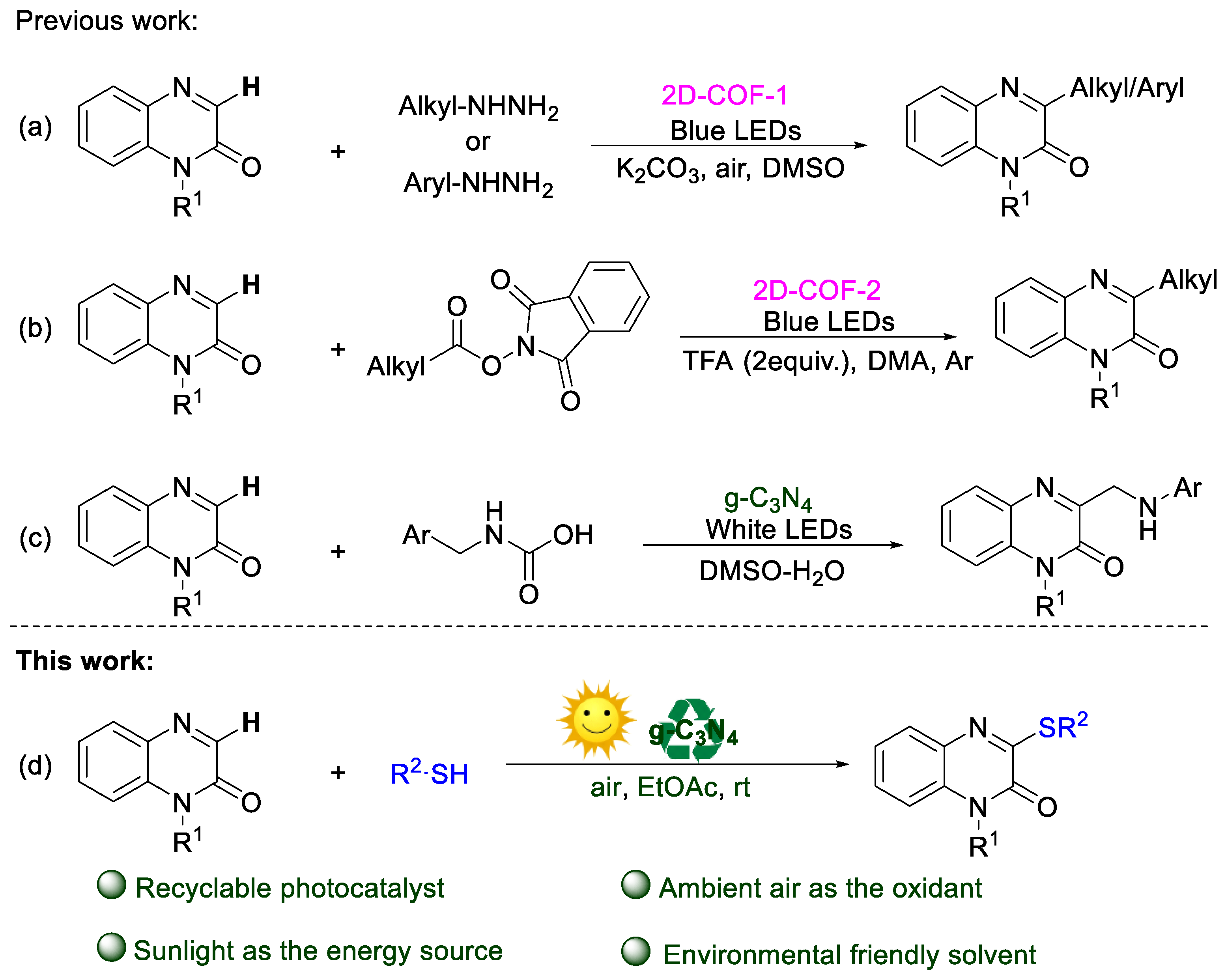

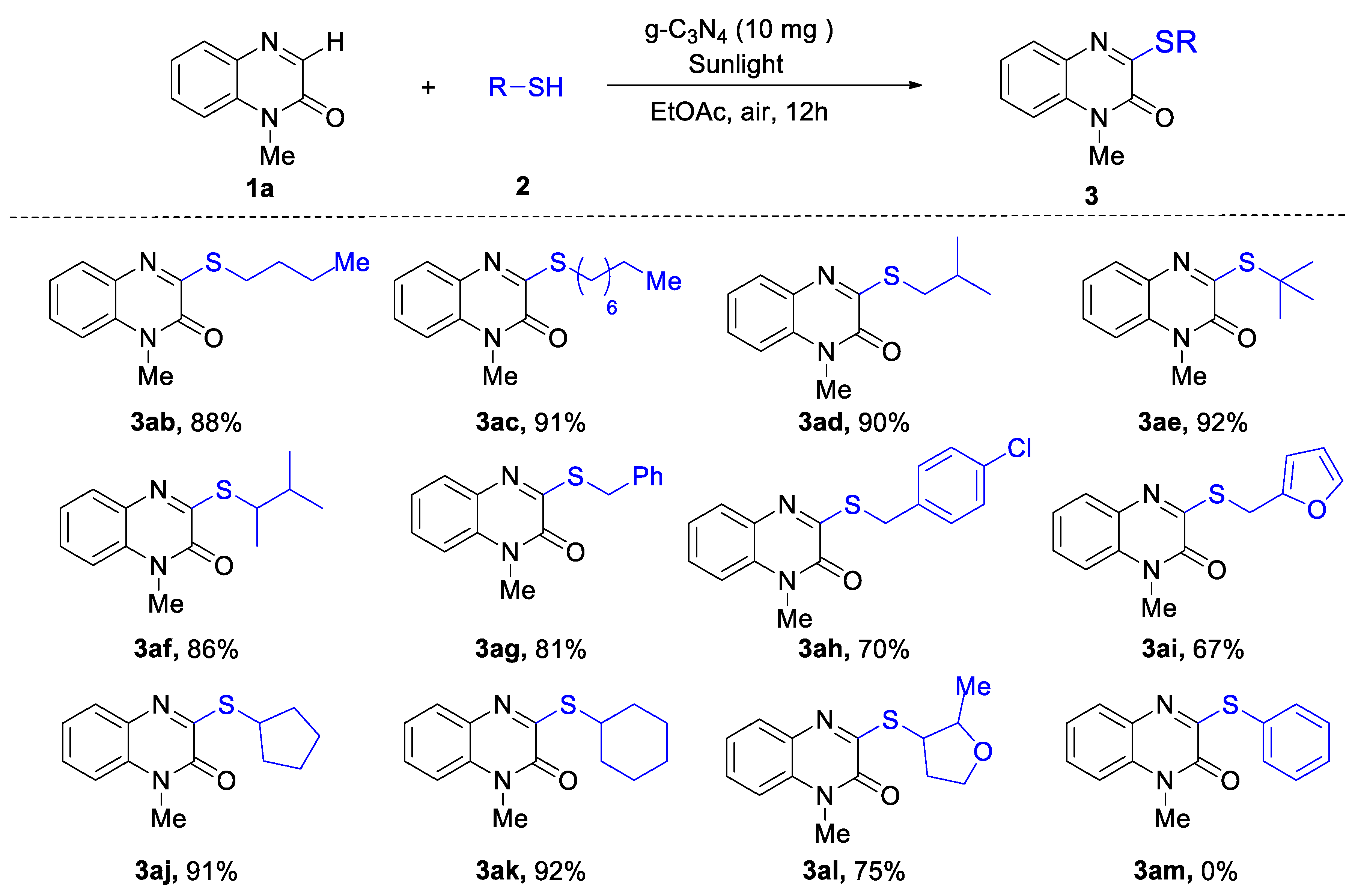

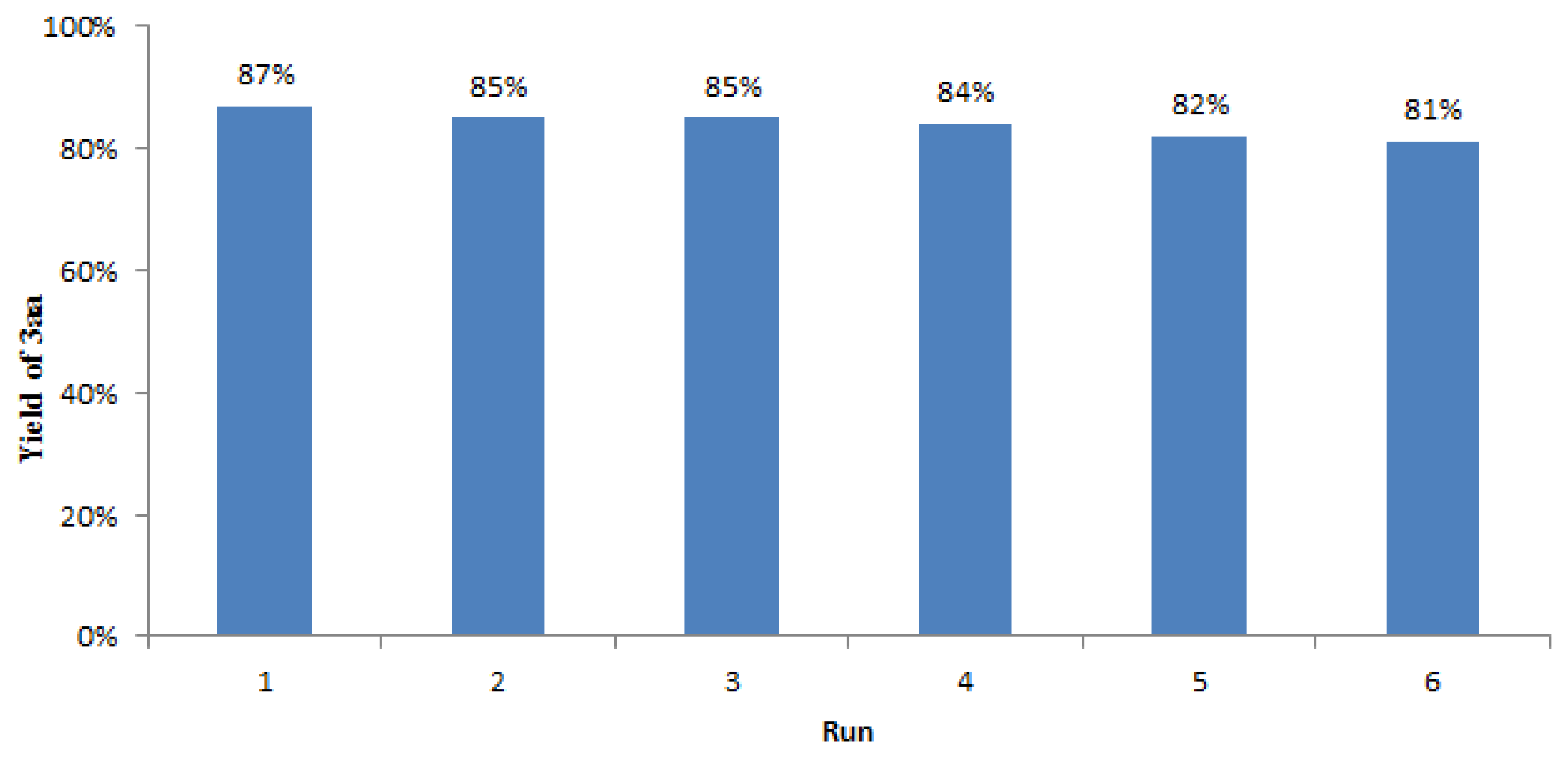
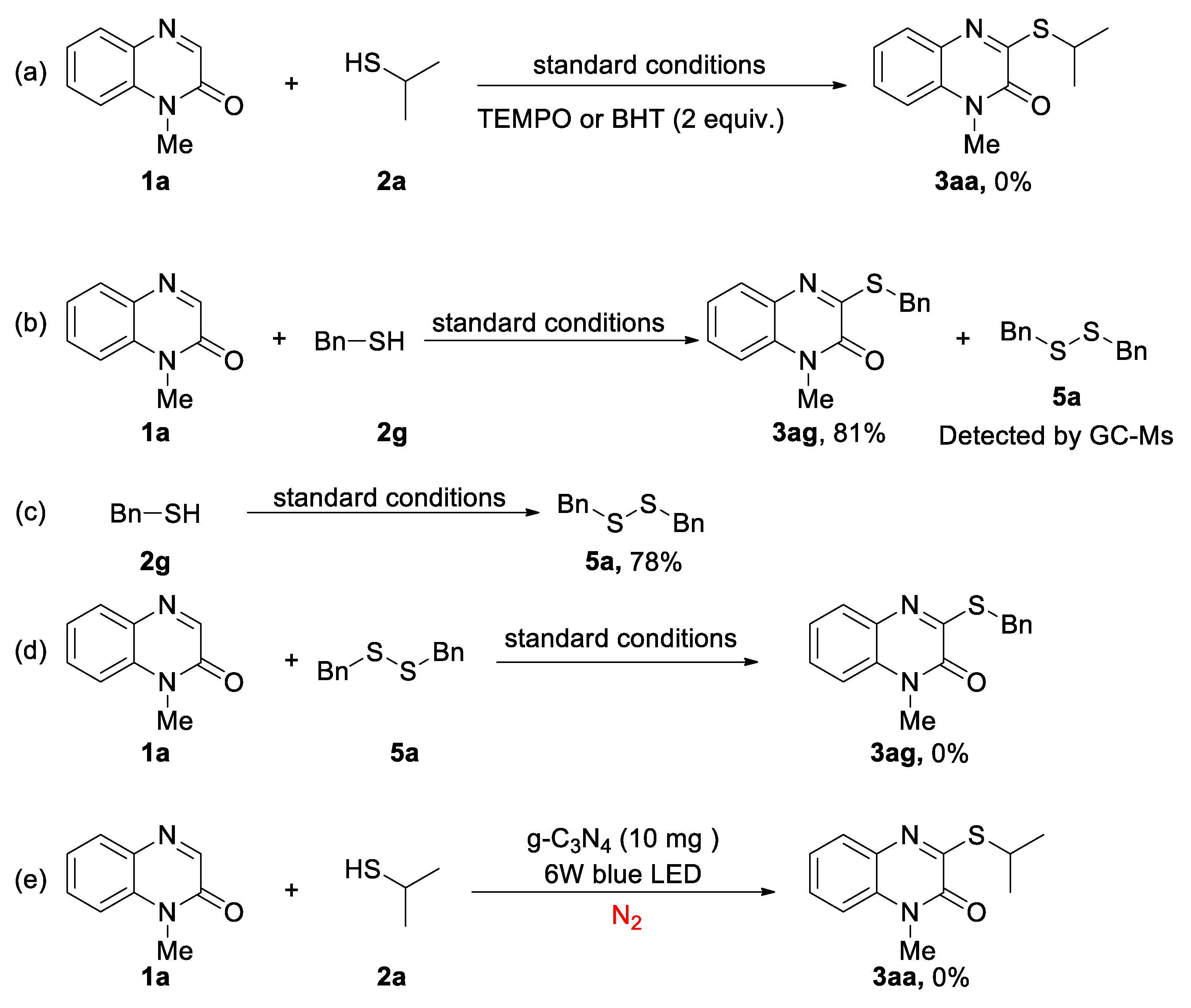
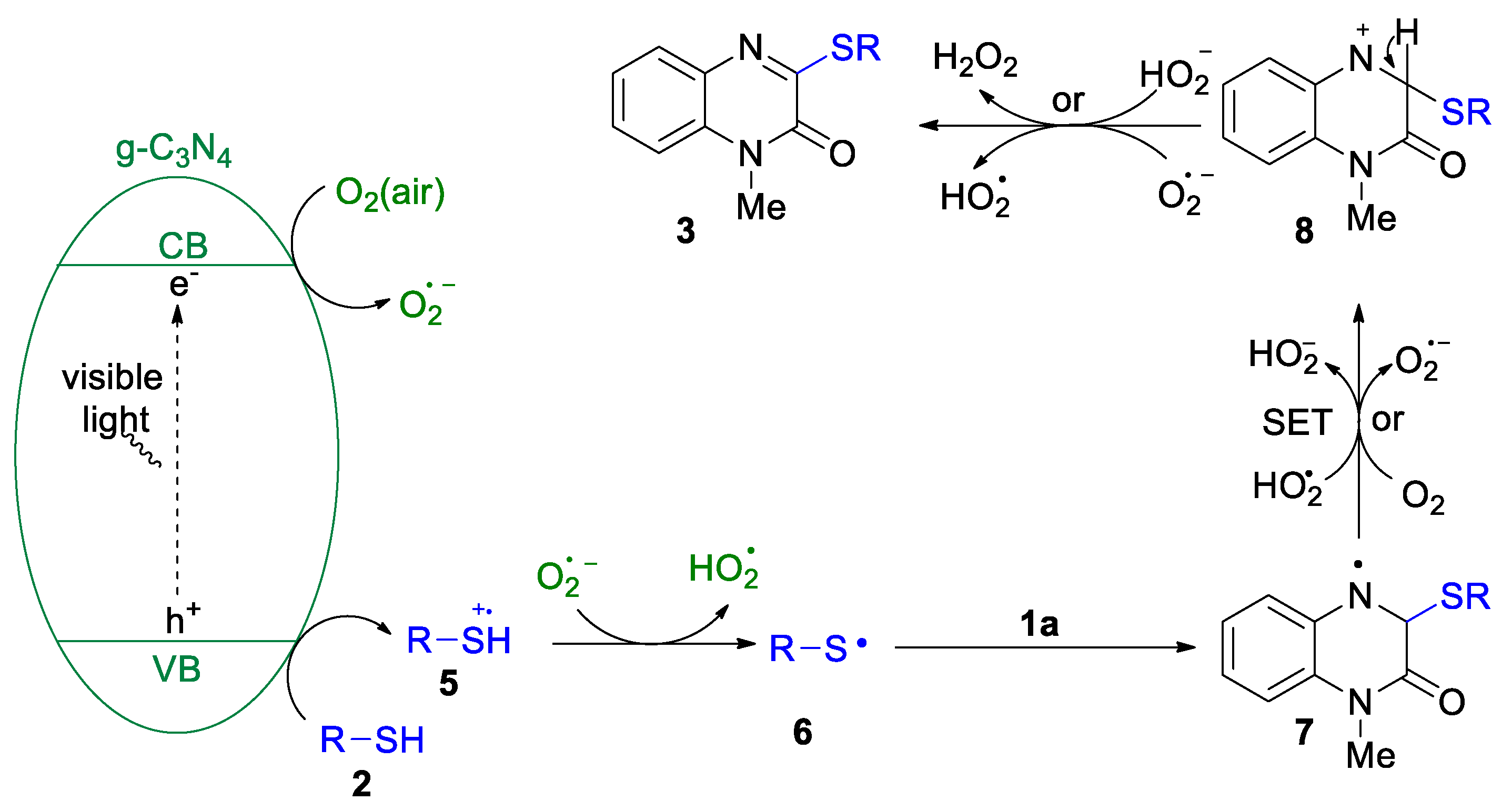

| Entry | Light Source | Photocatalyst | Solvent | Yield of 3aa b |
| 1 | Blue (6 W, 450–455 nm) | g-C3N4 (10 mg) | THF | 72% |
| 2 | Blue (6 W, 450–455 nm) | g-C3N4 (10 mg) | DCE | 74% |
| 3 | Blue (6 W, 450–455 nm) | g-C3N4 (10 mg) | CH3CN | 8% |
| 4 | Blue (6 W, 450–455 nm) | g-C3N4 (10 mg) | EtOAc | 82% |
| 5 | Blue (6 W, 450–455 nm) | g-C3N4 (10 mg) | EtOH | 62% |
| 6 | Blue (6 W, 450–455 nm) | g-C3N4 (10 mg) | DMSO | 41% |
| 7 | Blue (6 W, 450–455 nm) | g-C3N4 (10 mg) | H2O | 0% |
| 8 | Sunlight | g-C3N4 (10 mg) | EtOAc | 87% |
| 9 | Green (6 W, 520–525 nm) | g-C3N4 (10 mg) | EtOAc | 0% |
| 10 | White (6 W) | g-C3N4 (10 mg) | EtOAc | 67% |
| 11 | Purple (6 W, 370–375 nm) | g-C3N4 (10 mg) | EtOAc | 74% |
| 12 | Sunlight | g-C3N4 (15 mg) | EtOAc | 87% |
| 13 | Sunlight | g-C3N4 (5 mg) | EtOAc | 71% |
| 14 c | Sunlight | g-C3N4 (10 mg) | EtOAc | 0% |
| 15 | None | g-C3N4 (10 mg) | EtOAc | 0% |
| 16 | Sunlight | None | EtOAc | 0% |
Publisher’s Note: MDPI stays neutral with regard to jurisdictional claims in published maps and institutional affiliations. |
© 2022 by the authors. Licensee MDPI, Basel, Switzerland. This article is an open access article distributed under the terms and conditions of the Creative Commons Attribution (CC BY) license (https://creativecommons.org/licenses/by/4.0/).
Share and Cite
Peng, S.; Liu, J.; Yang, L.-H.; Xie, L.-Y. Sunlight Induced and Recyclable g-C3N4 Catalyzed C-H Sulfenylation of Quinoxalin-2(1H)-Ones. Molecules 2022, 27, 5044. https://doi.org/10.3390/molecules27155044
Peng S, Liu J, Yang L-H, Xie L-Y. Sunlight Induced and Recyclable g-C3N4 Catalyzed C-H Sulfenylation of Quinoxalin-2(1H)-Ones. Molecules. 2022; 27(15):5044. https://doi.org/10.3390/molecules27155044
Chicago/Turabian StylePeng, Sha, Jiao Liu, Li-Hua Yang, and Long-Yong Xie. 2022. "Sunlight Induced and Recyclable g-C3N4 Catalyzed C-H Sulfenylation of Quinoxalin-2(1H)-Ones" Molecules 27, no. 15: 5044. https://doi.org/10.3390/molecules27155044
APA StylePeng, S., Liu, J., Yang, L.-H., & Xie, L.-Y. (2022). Sunlight Induced and Recyclable g-C3N4 Catalyzed C-H Sulfenylation of Quinoxalin-2(1H)-Ones. Molecules, 27(15), 5044. https://doi.org/10.3390/molecules27155044







